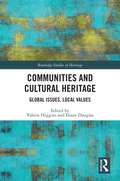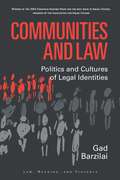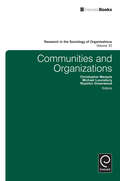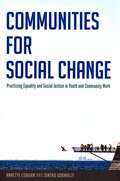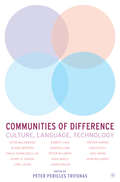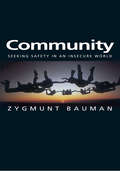- Table View
- List View
Communities and Cultural Heritage: Global Issues, Local Values
by Valerie HigginsCommunities and Cultural Heritage explores the relationship between communities, their cultural heritage and the global forces that control most of the world’s wealth and resources in today’s world. Bringing together scholars and heritage practitioners from nine countries, this book contributes to the ongoing dialogue on community heritage by analysing impediments to full community participation. The underminin of local communities comes at a high price. As the chapters in this book demonstrate, the knowledge embedded within traditional and Indigenous heritage creates communities that are more resilient to environmental and social stressors and more responsive to contemporary challenges such as climate change, environmental degradation, post-disaster recovery and relocation. Cultural heritage practices often fail to capitalise upon local knowledge and traditional skills and undervalue the potential contribution of local communities in finding creative and resourceful solutions to the issues they are confronting. Arguing that the creation of successful community heritage project requires ongoing reflection on the aims, methods, financing and acceptable outcomes of projects, the volume also demonstrates that the decolonization of Western-focussed heritage practices is an ongoing process, by which subaltern groups are brought forward and given a space in the heritage narrative. Reflecting on trends that impact communities and heritage sites across different geographical regions, Communities and Cultural Heritage will be of interest to academics, students and practitioners of cultural heritage,archaeology and anthropology around the world.
Communities and Cultural Heritage: Global Issues, Local Values
by Valerie Higgins Diane DouglasCommunities and Cultural Heritage explores the relationship between communities, their cultural heritage and the global forces that control most of the world’s wealth and resources in today’s world. Bringing together scholars and heritage practitioners from nine countries, this book contributes to the ongoing dialogue on community heritage by analysing impediments to full community participation. The underminin of local communities comes at a high price. As the chapters in this book demonstrate, the knowledge embedded within traditional and Indigenous heritage creates communities that are more resilient to environmental and social stressors and more responsive to contemporary challenges such as climate change, environmental degradation, post-disaster recovery and relocation. Cultural heritage practices often fail to capitalise upon local knowledge and traditional skills and undervalue the potential contribution of local communities in finding creative and resourceful solutions to the issues they are confronting. Arguing that the creation of successful community heritage project requires ongoing reflection on the aims, methods, financing and acceptable outcomes of projects, the volume also demonstrates that the decolonization of Western-focussed heritage practices is an ongoing process, by which subaltern groups are brought forward and given a space in the heritage narrative. Reflecting on trends that impact communities and heritage sites across different geographical regions, Communities and Cultural Heritage will be of interest to academics, students and practitioners of cultural heritage,archaeology and anthropology around the world.
Communities and Law: Politics and Cultures of Legal Identities (Law, Meaning, And Violence)
by Gad BarzilaiCommunities and Law looks at minorities, or nonruling communities, and their identity practices under state domination in the midst of globalization. It examines six sociopolitical dimensions of community--nationality, social stratification, gender, religion, ethnicity, and legal consciousness--within the communitarian context and through their respective legal cultures. Gad Barzilai addresses such questions as: What is a communal legal culture, and what is its relevance for relations between state and society in the midst of globalization? How do nonliberal communal legal cultures interact with transnational American-led liberalism? Is current liberalism, with its emphasis on individual rights, litigation, and adjudication, sufficient to protect pluralism and multiculturalism? Why should democracies encourage the collective rights of nonruling communities and protect nonliberal communal cultures in principle and in practice? He looks at Arab-Palestinians, feminists, and ultra-Orthodox Jews in Israel as examples of the types of communities discussed. Communities and Law contributes to our understanding of the severe tensions between democracies, on the one hand, and the challenge of their minority communities, on the other, and suggests a path toward resolving the resulting critical issues. Gad Barzilai is Professor of Political Science and Law and Co-Director of the Law, Politics and Society Program, Department of Political Science, Tel Aviv University.
Communities and Livelihood Strategies in Developing Countries
by Keshav Lall MaharjanSustainability of rural communities is threatened by a plethora of factors including climate change and disasters which interact in an intricate manner in making rural people vulnerable and poor. This book is the output of empirical research on communities and livelihood strategies in developing countries. It reveals how rural communities are functioning and earning their livelihoods by making the best use of the resources, local/internal or external/new and the combination of the two to counteract the various challenges they face, with the ultimate goal of becoming resilient to local or global shocks and sustaining that resilience. Local governance is identified as crucial in ensuring sustainable livelihoods as it ensures healthy collaboration between communities, on the one hand and civil society and those communities, on the other hand, in promoting self-sustaining development trajectories. Similarly, the role of social capital is not ignored as it brings in community drive and a sense of purpose, direction and solidarity among community members which facilitates problem solving in periods of crises and disasters.
Communities and Networks: Using Social Network Analysis to Rethink Urban and Community Studies
by Katherine GiuffreIn Communities and Networks, Katherine Giuffre takes the science of social network analysis and applies it to key issues of living in communities, especially in urban areas, exploring questions such as: How do communities shape our lives and identities? How do they foster either conformity or innovation? What holds communities together and what happens when they fragment or fall apart? How is community life changing in response to technological advances? Refreshingly accessible and built on fascinating case examples, this unique book provides not only the theoretical grounding necessary to understand how and why the burgeoning area of social network analysis can be useful in studying communities, but also clear technical explanations of the tools of network analysis and how to gather and analyze real-world network data. Network analysis allows us to see community life in a new perspective, with sometimes surprising results and insights, and this book enables readers to gain a deeper understanding of social life and the relationships that build (and break) communities. This engaging text will be an exciting new resource for upper-level undergraduate and beginning graduate students in a wide range of courses including social network analysis, community studies, urban studies, organizational studies, and quantitative methods.
Communities and Networks: Using Social Network Analysis to Rethink Urban and Community Studies
by Katherine GiuffreIn Communities and Networks, Katherine Giuffre takes the science of social network analysis and applies it to key issues of living in communities, especially in urban areas, exploring questions such as: How do communities shape our lives and identities? How do they foster either conformity or innovation? What holds communities together and what happens when they fragment or fall apart? How is community life changing in response to technological advances? Refreshingly accessible and built on fascinating case examples, this unique book provides not only the theoretical grounding necessary to understand how and why the burgeoning area of social network analysis can be useful in studying communities, but also clear technical explanations of the tools of network analysis and how to gather and analyze real-world network data. Network analysis allows us to see community life in a new perspective, with sometimes surprising results and insights, and this book enables readers to gain a deeper understanding of social life and the relationships that build (and break) communities. This engaging text will be an exciting new resource for upper-level undergraduate and beginning graduate students in a wide range of courses including social network analysis, community studies, urban studies, organizational studies, and quantitative methods.
Communities and Organizations (Research in the Sociology of Organizations #33)
by Chris Marquis Michael Lounsbury Royston GreenwoodHow does organizations' embeddedness in broader social and cultural communities influence their behavior? And how has this changed with recent communication technology advances and globalization trends? In this volume, we consider how diverse types of communities influence organizations, as well as the associated benefit of developing a richer accounting for community processes in organizational theory. One goal of the volume is to move beyond the focus on social proximity and networks that has characterized existing work on communities. The papers in this volume consider specific topics that expand the definition of community beyond geography to include how transnational communities form and affect organizations' perception, the development of a community-form (C-form) organization as an important organizational architecture for understanding twenty-first century business, and how virtual communities influence key organizational processes. While there has been a recent revival of research into the effects of both geographic and non-geographic communities on organizational behaviors, this volume is the first effort to bring both perspectives together in order to aid in the identification of common and disparate mechanisms across multiple types of communities and how community as an organizing logic sits vis-a-vis other logics related to the market, corporation, family and religion.
Communities For Social Change: Practicing Equality and Social Justice in Youth and Community Work (PDF) (Counterpoints #509)
by Annette Coburn Sinéad GormallyCommunities for Social Change: Practicing Equality and Social Justice in Youth and Community Work examines core ideas of social justice and equality that underpin community and youth work. It informs understanding of a range of community concepts and practices that are used to identify practical skills and characteristics that can help to promote equality by challenging injustice. Working with people in different types of community can bring the kind of social change that makes a real and lasting difference. Although justice is a contested notion, Annette Coburn and Sinéad Gormally assert that it is closely interlinked with human rights and equality. A critical examination of contemporary literature draws on educational, sociological, and psychological perspectives, to set community practices within a context for learning that is conversational, critical and informal. Social justice is about identifying and seeking to address structural disadvantage, discrimination, and inequality. The authors assert that by refocusing on process, participation, and collective rights, it is possible to create and sustain social justice. Transformative research paradigms help to produce findings that inspire and underpin political social action, and an analysis of practice-based examples supports the promotion of increased critical consciousness. This makes Communities for Social Change a must-read for anyone studying or teaching community youth work or who is working in communities or with individuals who experience oppression or inequality. If you are committed to teaching and learning about theory and practice that promotes social change for equality and social justice, you will not be disappointed!
Communities in Cyberspace
by Peter Kollock Marc SmithThis wide-ranging introductory text looks at the virtual community of cyberspace and analyses its relationship to real communities lived out in today's societies. Issues such as race, gender, power, economics and ethics in cyberspace are grouped under four main sections and discussed by leading experts: * identity* social order and control* community structure and dynamics* collective action. This topical new book displays how the idea of community is being challenged and rewritten by the increasing power and range of cyberspace. As new societies and relationships are formed in this virtual landscape, we now have to consider the potential consequences this may have on our own community and societies. Clearly and concisely written with a wide range of international examples, this edited volume is an essential introduction to the sociology of the internet. It will appeal to students and professionals, and to those concerned about the changing relationships between information technology and a society which is fast becoming divided between those on-line and those not.
Communities in Cyberspace
by Peter Kollock Marc SmithThis wide-ranging introductory text looks at the virtual community of cyberspace and analyses its relationship to real communities lived out in today's societies. Issues such as race, gender, power, economics and ethics in cyberspace are grouped under four main sections and discussed by leading experts: * identity* social order and control* community structure and dynamics* collective action. This topical new book displays how the idea of community is being challenged and rewritten by the increasing power and range of cyberspace. As new societies and relationships are formed in this virtual landscape, we now have to consider the potential consequences this may have on our own community and societies. Clearly and concisely written with a wide range of international examples, this edited volume is an essential introduction to the sociology of the internet. It will appeal to students and professionals, and to those concerned about the changing relationships between information technology and a society which is fast becoming divided between those on-line and those not.
Communities, Land and Social Innovation: Land Taking and Land Making in an Urbanising World
by Asiya Sadiq Frank Moulaert Han Verschure Ide Hiergens Monica Quintana Molina Pieter Van den BroeckThis timely and thought-provoking book examines the contemporary struggle of communities over land ownership and use rights in rapidly urbanising areas. Analysing 12 key case studies from across four continents, it demonstrates changes in land and housing tenancy systems, showing how communities have revolted against the land hunger of speculators, agrobusiness and technocratic local authorities. Contributions from an international team of researchers, policy analysts and experts explore both neoliberal urban development policies and socially innovative initiatives, discussing different modes of solidarity action and commons building to ensure both access to land and housing security. Chapters also introduce a critical governance perspective to land tenure dynamics and examine the increasingly prominent hybridisation of land use rights systems and land markets, providing a state-of-the-art reflection of the field and contributing to an agenda for future research, policy and practice. Academics studying urban and regional planning, social innovation, and commoning will find this book to be essential reading. It will also interest policy makers and civil society organisations looking for a stronger understanding of land dynamics and urbanisation in order to set up new forms of land governance.
Communities, Neighborhoods, and Health: Expanding the Boundaries of Place (Social Disparities in Health and Health Care #1)
by Linda M. Burton, Stephen A. Matthews, ManChui Leung, Susan P. Kemp and David T. TakeuchiPlace is an important element in understanding health and health care disparities. More that merely a geographic location, place is a socio-ecological force with detectable effects on social life, independent well-being, and health. Despite the general enthusiasm for the study of place and the potential it could have for a better understanding of the distribution of health in different communities, research is at a difficult crossroads because of disagreements in how the construct should be conceptualized and measured. This edited volume incorporates an cross-disciplinary approach to the study of place, in order to come up with a comprehensive and useful definition of place. Topics covered include: Social Inequalities, Historical Definitions of Place, Biology and Place, Rural vs. Urban Places, Racialization of a Place, Migration, Sacred Places, Technological Innovations An understanding of place is essential for health care professionals, as interventions often do not have the same effects in the clinic as they do in varied, naturalistic social settings.
Communities, Networks and Ethnic Politics (Routledge Revivals)
by Ken HahloFirst Published in 1998, this study explores ethnic community political participation in local politics in the North West British town. The analysis is located within the framework of the shift from Fordism to post-Fordism.From 1965 to 1980 ethnic communities increased their access to scarce resources including political influence by engaging in ethnic politics. Using membership of religious organisations as structures of support, elected men deployed ethnic identities to compete with others for ethnic support and influence over local decision-making processes. This gave ethnic minorities a positive role in local politics. With the support of local community relations councils (CRCs), ethnic politics flourished. It gave ethnic communities real opportunities to participate as ethnic communities in politics. Using local events, ethnic leaders competed for political influence and ethnic support. After 1977 the shift from Fordism to post-Fordism brought about a decline in ethnic political participation. While conferment of citizenship secured their right to stay in Britain, the rise in consumerism undermined the manufacturing sector on which they depended for work. With no ethnic political identity, today, these communities are again politically disadvantaged.
Communities, Networks and Ethnic Politics (Routledge Revivals)
by Ken HahloFirst Published in 1998, this study explores ethnic community political participation in local politics in the North West British town. The analysis is located within the framework of the shift from Fordism to post-Fordism.From 1965 to 1980 ethnic communities increased their access to scarce resources including political influence by engaging in ethnic politics. Using membership of religious organisations as structures of support, elected men deployed ethnic identities to compete with others for ethnic support and influence over local decision-making processes. This gave ethnic minorities a positive role in local politics. With the support of local community relations councils (CRCs), ethnic politics flourished. It gave ethnic communities real opportunities to participate as ethnic communities in politics. Using local events, ethnic leaders competed for political influence and ethnic support. After 1977 the shift from Fordism to post-Fordism brought about a decline in ethnic political participation. While conferment of citizenship secured their right to stay in Britain, the rise in consumerism undermined the manufacturing sector on which they depended for work. With no ethnic political identity, today, these communities are again politically disadvantaged.
Communities of Difference: Culture, Language, Technology
by P. TrifonasThis book will look at the implications of educational practices in communities that are differentiated by issues of language, culture, and technology. Trifonas argues that a 'community' is at once a gathering of like-minded individuals in solidarity of purpose and conviction, and also a gathering that excludes others. The chapters in this collection will reveal this tension between theory and practice in order to engage the models of community and the theories of difference that support them as a way to teach, to learn, and to know.
Communities of Hustling: Die Bewältigung urbaner Marginalisierung als Kunst sich zu arrangieren (Studien zur Kindheits- und Jugendforschung #7)
by Daniel GanzertDiese ethnographische Studie von Daniel Ganzert untersucht Erfahrungen und informelle Bildungspraktiken männlicher Jugendlicher in marginalisierten Großstadtquartieren in Italien und Deutschland. Der Autor zeigt auf, wie junge Männer in Kontexten dauerhafter Prekarität, geringer Institutionalisierung und in Auseinandersetzung mit organisierter Kriminalität kreative Praktiken der Lebensbewältigung, der Mobilität, des Wissenserwerbs und -transfers sowie der Erwerbstätigkeit entwickeln. Hierfür wurden lange Feldbeobachtungen, Gruppendiskussionen und biographische Interviews realisiert, die dokumentarisch ausgewertet wurden.
Communities of Practice: Fostering Peer-to-Peer Learning and Informal Knowledge Sharing in the Work Place (Information Science and Knowledge Management #13)
by Noriko Hara1.1 Introduction Each year corporations spend millions of dollars training and educating their - ployees. On average, these corporations spend approximately one thousand dollars 1 per employee each year. As businesses struggle to stay on the cutting-edge and to keep their employees educated and up-to-speed with professional trends as well as ever-changing information needs, it is easy to see why corporations are investing more time and money than ever in their efforts to support their employees’ prof- sional development. During the Industrial Age, companies strove to control natural resources. The more resources they controlled, the greater their competitive edge in the mark- place. Senge (1993) refers to this kind of organization as resource-based. In the Information Age, companies must create, disseminate, and effectively use kno- edge within their organization in order to maintain their market share. Senge - scribes this kind of organization as knowledge-based. Given that knowledge-based organizations willcontinuetobeadrivingforcebehindtheeconomy, itisimperative that corporations support the knowledge and information needs of their workers.
Communities of Practice and Vintage Innovation: A Strategic Reaction to Technological Change (SpringerBriefs in Business)
by Francesco SchiavoneThis book focuses on the notion of “vintage innovation” and its application in various old technology-based communities of practice. Some communities of practice resist and react to technological change by adopting new technological products (“vintage products”) that extend the lifetime of their old, favored products and practices. There are a number of potential reasons for such strategic reactions, which are analyzed by the author. The book opens by reviewing the nature of technological change. Old technology-based communities of practice and their typical reactions to technological change are then discussed, and the concept of vintage innovation, introduced and explained. The book presents four case studies of communities of users in which vintage innovation emerged: analog photographers, radio amateurs, arcade videogame players, and disc jockeys.
Communities of Practice at the World Bank: Breaking Knowledge Silos to Catalyze Culture Change and Organizational Transformation
by Ede Ijjasz-Vasquez Philip Karp Monika Weber-FahrIllustrated by the experience of the World Bank, this book explains how knowledge management, traditionally viewed as being about information systems and processes, can play a fundamental corporate role by creating a competitive edge for organizations, increasing team performance, and fostering effective, large-scale organizational change. Rich and powerful stories, told by economic development practitioners and knowledge management specialists throughout the World Bank, describe the strategies, instruments, tools, and processes at the core of one of the most important and radical reorganizations of the world’s premier international development institution. Going far beyond other knowledge management titles, this book: shows how knowledge management can be a source of competitive advantage and team performance, rather than a back-room support function focuses on the role of the "software" of knowledge management, most notably the use of communities, culture, and collaboration across internal silos to create value; and demonstrates the role that knowledge management can play in fostering innovation, and development of new business lines and strategies by global teams in diverse locations Written not only for knowledge management professionals, but also for C-suite executives and middle managers who will see the benefits of bringing knowledge management to the core of organizational performance and competitive advantage, the book provides practical examples that can be replicated in other large global knowledge, financing, and development institutions and that will be relevant for public, private, and non-profit organizations.
Communities of Practice at the World Bank: Breaking Knowledge Silos to Catalyze Culture Change and Organizational Transformation
Illustrated by the experience of the World Bank, this book explains how knowledge management, traditionally viewed as being about information systems and processes, can play a fundamental corporate role by creating a competitive edge for organizations, increasing team performance, and fostering effective, large-scale organizational change. Rich and powerful stories, told by economic development practitioners and knowledge management specialists throughout the World Bank, describe the strategies, instruments, tools, and processes at the core of one of the most important and radical reorganizations of the world’s premier international development institution. Going far beyond other knowledge management titles, this book: shows how knowledge management can be a source of competitive advantage and team performance, rather than a back-room support function focuses on the role of the "software" of knowledge management, most notably the use of communities, culture, and collaboration across internal silos to create value; and demonstrates the role that knowledge management can play in fostering innovation, and development of new business lines and strategies by global teams in diverse locations Written not only for knowledge management professionals, but also for C-suite executives and middle managers who will see the benefits of bringing knowledge management to the core of organizational performance and competitive advantage, the book provides practical examples that can be replicated in other large global knowledge, financing, and development institutions and that will be relevant for public, private, and non-profit organizations.
Communities of Practice in Language Research: A Critical Introduction
by Brian W. KingCommunities of Practice in Language Research provides an up-to-date and critical introduction to the community of practice framework and how this can be applied to language research. Critiquing and offering alternative suggestions for the ways in which researchers frame research participants as members of communities of practice, with the goal of inspiring use of the Community of Practice (CofP) model in new areas of research, this book: engages in extended critical analysis of past research as well as questioning recent applications and suggesting limitations incorporates instructive examples from multiple fields, including Sociolinguistics, Linguistic Anthropology, Critical Discourse Studies, Language Teaching & Learning, Literacy Studies, and a trailblazing section on Language & Digital Media brings up-to-date the key questions and concerns around the Communities of Practice model, debunking myths and re-emphasising ongoing challenges. Communities of Practice in Language Research is essential reading for undergraduate and postgraduate students studying research methods or undertaking research projects in those areas.
Communities of Practice in Language Research: A Critical Introduction
by Brian W. KingCommunities of Practice in Language Research provides an up-to-date and critical introduction to the community of practice framework and how this can be applied to language research. Critiquing and offering alternative suggestions for the ways in which researchers frame research participants as members of communities of practice, with the goal of inspiring use of the Community of Practice (CofP) model in new areas of research, this book: engages in extended critical analysis of past research as well as questioning recent applications and suggesting limitations incorporates instructive examples from multiple fields, including Sociolinguistics, Linguistic Anthropology, Critical Discourse Studies, Language Teaching & Learning, Literacy Studies, and a trailblazing section on Language & Digital Media brings up-to-date the key questions and concerns around the Communities of Practice model, debunking myths and re-emphasising ongoing challenges. Communities of Practice in Language Research is essential reading for undergraduate and postgraduate students studying research methods or undertaking research projects in those areas.
Communities on the Margin: Disadvantaged Populations in Indian Society
by Saiyed Nadeemul HasnainThis book probes into the marginalized communities of the Indian society through historical and contemporary societal perspectives. It discusses socio-cultural aspects of the experiences of Scheduled Castes, Dalits, Scheduled Tribes/tribal communities, Other Backward Classes, linguistic minorities, religious minorities and the queer/LGBT as sexual minorities.Adopting an inter-disciplinary approach, it looks at all these segments of Indian society through historical and societal perspectives. Divided into three broad sections – Scheduled Castes, Scheduled Tribes, and minorities, this book provides historical perspective backed by the contemporary situation and emerging social changes among these communities. Written in a lucid manner, the book aims to reach and impact readers without having any prior academic exposure to this subject area.This book would be useful to the students, researchers and teachers of sociology, social work, history, economics, political science, and other interdisciplinary courses in social sciences. The book will also be valuable reading for those interested in South Asian studies, especially contemporary Indian society.
Communities on the Margin: Disadvantaged Populations in Indian Society
by Saiyed Nadeemul HasnainThis book probes into the marginalized communities of the Indian society through historical and contemporary societal perspectives. It discusses socio-cultural aspects of the experiences of Scheduled Castes, Dalits, Scheduled Tribes/tribal communities, Other Backward Classes, linguistic minorities, religious minorities and the queer/LGBT as sexual minorities.Adopting an inter-disciplinary approach, it looks at all these segments of Indian society through historical and societal perspectives. Divided into three broad sections – Scheduled Castes, Scheduled Tribes, and minorities, this book provides historical perspective backed by the contemporary situation and emerging social changes among these communities. Written in a lucid manner, the book aims to reach and impact readers without having any prior academic exposure to this subject area.This book would be useful to the students, researchers and teachers of sociology, social work, history, economics, political science, and other interdisciplinary courses in social sciences. The book will also be valuable reading for those interested in South Asian studies, especially contemporary Indian society.
Community: Seeking Safety in an Insecure World (Themes for the 21st Century #3)
by Zygmunt Bauman'Community' is one of those words that feels good: it is good 'to have a community', 'to be in a community'. And 'community' feels good because of the meanings which the word conveys, all of them promising pleasures, and more often than not the kind of pleasures which we would like to experience but seem to miss. 'Community' conveys the image of a warm and comfortable place, like a fireplace at which we warm our hands on a frosty day. Out there, in the street, all sorts of dangers lie in ambush; in here, in the community, we can relax and feel safe. 'Community' stands for the kind of world which we long to inhabit but which is not, regrettably, available to us. Today 'community' is another name for paradise lost - but for a paradise which we still hope to find, as we feverishly search for the roads that may lead us there. But there is a price to be paid for the privilege of being in a community. Community promises security but seems to deprive us of freedom, of the right to be ourselves. Security and freedom are two equally precious and coveted values which could be balanced to some degree, but hardly ever fully reconciled. The tension between security and freedom, and between community and individuality, is unlikely ever to be resolved. We cannot escape the dilemma but we can take stock of the opportunities and the dangers, and at least try to avoid repeating past errors. In this important new book, Zygmunt Bauman takes stock of these opportunities and dangers and, in his distinctive and brilliant fashion, offers a much-needed reappraisal of a concept that has become central to current debates about the nature and future of our societies.
